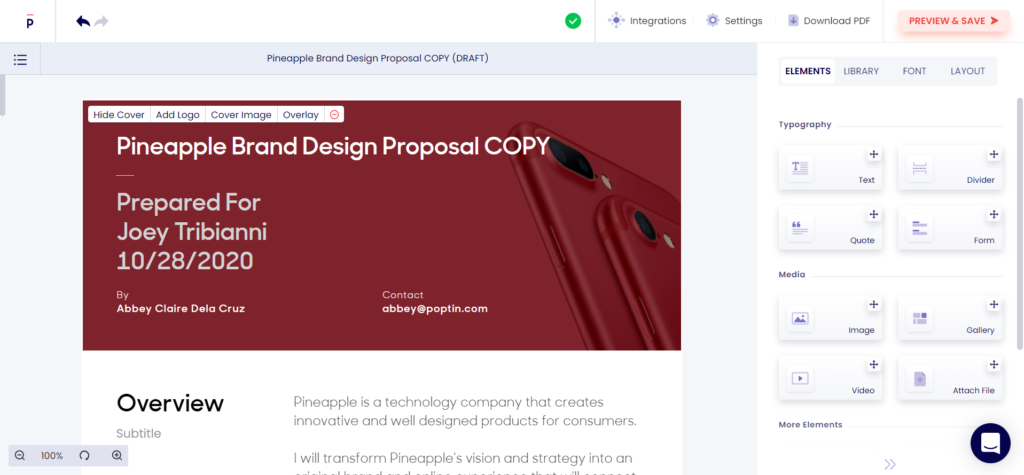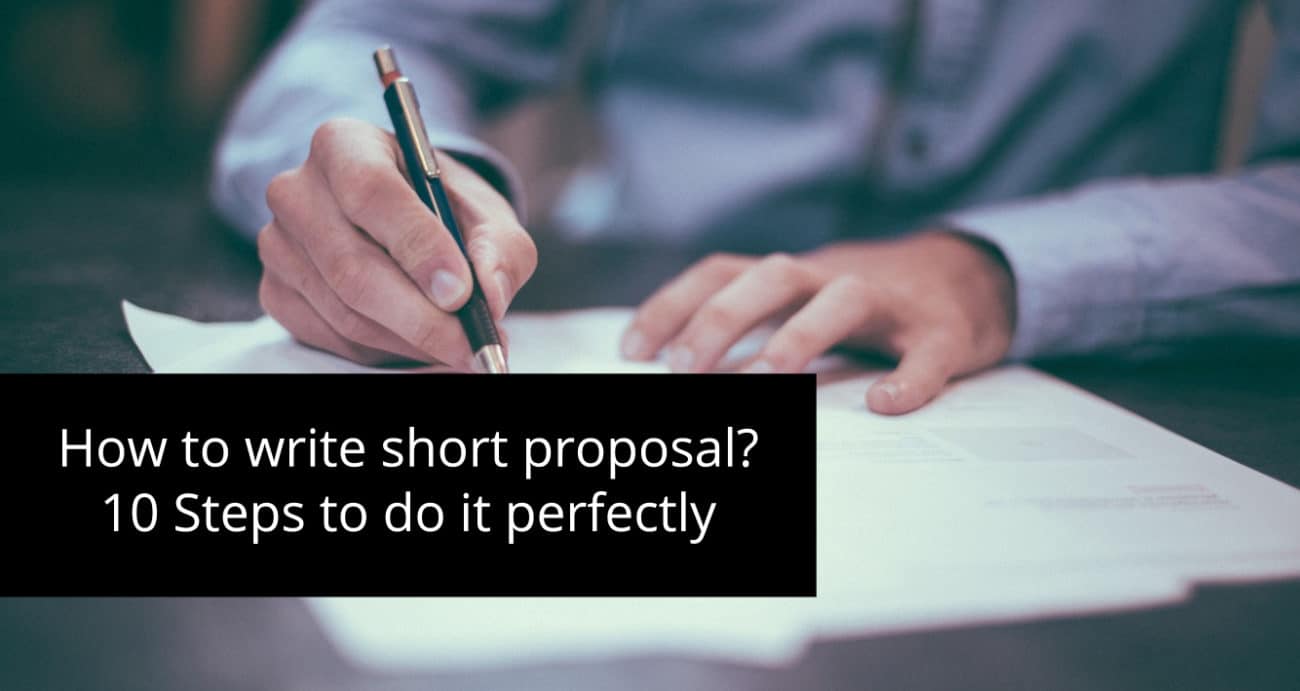Some clients, job positions, or specific projects do not require a lengthy and overly detailed proposal.
Short proposals are generally sought when it comes to short projects. It is essential for the client to see who is applying for the assignment, what do you do in general, and similar.
What has also proven to be good practice is to demonstrate roughly in what way would you accomplish a task in question or solve a particular problem.
Of course, there is no reason to write the whole plan of the project. The client did not ask you to train him for what he was looking for, nor did you have to leave the job that was supposed to be yours to him.
In addition to being short, your proposal should be effective and show the client that you are the right person to fulfill their needs.
Creating a proposal causes problems for many people because they do not know what it should contain specifically.
Actually, creating proposals is very often a bigger challenge than creating the longer ones.
Therefore, we will show you in the following section what a great proposal should look like.
1. Do a research
Before you apply for a job, you should research the topic, the problem itself as well as the company if the necessary information is left on the website. This will help you generate a background for your proposal.
The time you will need for research depends on the topic and type of problem you are solving or the position you are applying for. It also depends on your current abilities and knowledge.
2. Write down your own table of content
More extensive proposals should include a table of content to make it easier for the client to find what they are looking for more quickly.
For shorter proposals, the table of content is optional unless you have a large number of smaller items that you want to include.
But, what is important for you is to create your table that will serve as a blueprint when you decide to begin writing and creating a proposal.
Write down the most important items, so you don’t miss anything. This will increase your organization and effectiveness. As you work, you will be able to check piece by piece and see not only how much time the table saved you but also how it increased your motivation.
3. Write an interesting introduction
The introduction is the first thing a client will see. Therefore, it must be interesting enough to make him pay attention and show him that he has a good reason to continue reading.
It will also be the beginning of your presentation. Make sure you stick to a few sentences that will provide enough information.
Avoid generic sentences that will take up both your and your employer’s time.
But don’t forget to introduce yourself as well
The client should get to know the person on the other side and become familiar with the potential employee whose only task is to get the job done as well as possible.
So don’t forget to briefly introduce yourself and give some key information about your experience so far.
This is where you should present your knowledge and skills and, if necessary, mention previous similar projects or jobs that you have done.
This way, you will build initial trust regarding your relationship with your client.
Of course, you shouldn’t overdo the information here either, so focus on what might be of value to the client.
If it is a proposal for a specific project, the plan you are writing should support the skills you have previously stated to possess.
4. Do not experiment with fonts
To make their proposal as effective as possible, people resort to different methods. One of them is the text font.
Still, one does not need to experiment too much with it. Even if you are in the creative business, do not display it this way. You will seem not serious enough, or you will make the text unreadable and that is certainly not the effect you want to achieve.
Choose simple, well-established fonts that are clear and readable, and reviewing your proposal will not ever be a bother.
5. Make your proposal error-free
Even with longer proposals, mistakes are something that shouldn’t happen whether it was grammar, letter or punctuation one.
One of the tools that correct grammatical errors is Grammarly.

It takes a few minutes to install it and it will serve you as some sort of assistant. It will even let you know if you accidentally made unnecessary spaces at some point.
Correct the short proposal errors before they become even more obvious, and be sure to read your proposal multiple times before sending it to the client.
6. Use proposal tools
Today, there are tools that can help you write proposals smoothly, saving you a lot of time.
Especially if you are not adept at writing this type of document or if you need to make multiple proposals in a short time, these tools will be of huge importance to you.
One of the best proposal tools on the market is Prospero.
It is a tool that will make creating proposals interesting and easy from now on.

Right from the start, you can enter all the information about:
- Client
- Project
- Yourself
- Pricing strategy
- Deliverables
- Milestones
Each item has its own subitems where you provide the necessary information. When you’re done, this feature actually uses them to make the most appropriate proposal for you. Therefore, it reduces the chances of forgetting important details.
It also contains ready-made templates and texts if you need help with writing.

If you have trouble presenting your strengths and possibilities, Prospero will help you write those parts as well.
All you have to do is choose which type of business are you in.
Using these tools makes it easy for you to do your work and allows you to write more proposals in a shorter period of time. This means, more potential jobs for you!
7. Customize your proposal
The proposal should first and foremost be a representation of your abilities, and you should focus on it the most. However, you need to be aware that clients receive loads of proposals on a day-to-day basis and you need to make sure yours stands out from the rest.
So, try to customize it.
You can choose from different templates, images, colors, and effects, as long as it looks professional and does not affect the clarity of the document itself.
It’s just an addition that should make your proposal more visually appealing and show that you have an eye for detail.
If necessary, insert infographics and tables that will say more with the picture than words describing specific examples ever could.
8. Don’t forget the e-signature option
Technology today has a lot to offer.
It should be used by all means, so don’t forget to add the electronic signature option. This will allow the client to sign the proposal immediately if needed.
This is another way to save both of you a great deal of time.
9. Add deadlines, fees, and payments
If it is a complex task that needs to be done, enter a deadline for each part of it. Be objective. Do not try to impress the client at any cost by setting unrealistically short deadlines.
You will leave a better impression if you set a realistic deadline, and, if possible, finish earlier, than fail to meet expectations.
Add your prices for each piece of work so the client has a clear overview. Also, write down if any potential changes requested by the client are included in the price or not.
This segment of the proposal should be concise and transparent.
10. Check and analyze your short proposal
After you have finished, review again to see if you have included everything needed in the proposal.
You need to make a great impression, so you better leave time in the end to check everything.
Analyze the proposal by putting yourself in the client’s perspective. If everything looks clear and tidy enough, your proposal is ready to send!
The bottom line
With these tips in mind, writing short proposals will no longer be a problem for you.
A good organization will allow you to write significant proposals without hassle or stalling.
If the client has given specific instructions and application parameters, make sure that you follow them as much as possible.
For some people, waiting for a response is more pressure than writing a proposal. This uncertainty can be a problem, especially since you do not know whether the client has reached and opened your proposal.
It would be great to know for sure, wouldn’t it?
Prospero lets you know when a client first opened your document, how many times he accessed it, and how much time he spent reviewing it. You can get all these notifications in your email and this way you can know exactly what’s going on.
If you no longer want to spend hours and hours writing proposals, try Prospero. It will guide you step by step throughout the whole process while saving you time to spend on other important tasks.
Now it’s time to present yourself in the best way possible!




